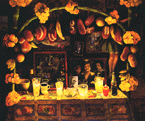I must have been
very well disposed and ready to perceive things in a certain way, when one
night, while driving through a poor neighborhood, I saw a grey brick house in
the darkness with a window that had a curtain of brilliant colors: pink with
blue flowers. With the light shining from inside the house it looked like a
movie screen. This vision hit me so hard that, once back home, I tried to
make a painting of it.
This was my first painting in a series that I later
called "Flor de Asfalto" (Asphalt Flower). This new style turned out to be an
answer for what I had been searching. I had finally found a new way to see
that gave a new sense to my surroundings, and with this new way of seeing, I
discovered more and more sources of inspiration. Slowly, I learned to
understand better what it all meant, in a way how it worked, both in the
landscapes and in the interior scenes.
If you judge a place like Mexico City
with classic values of order, symmetry, control of proportions, then you
won't like the results. You will only see disorder, chaos, and ugliness
everywhere.
In order to understand such an environment you have to change
your visual and aesthetic codes. First of all, you can't see it as something
static. The urban Mexican landscape is in constant change and it is in this
process where you can find its interest and beauty.
When we look at, let's
say, Venice (or even more so the Venice of Canaletto), you will see a
landscape that was created to last and to stay the way it was. It is there,
before you, easy to understand, logical, orderly, symmetrical. The city was
created-like the painting of the city was created-to be appreciated from
certain angles. As a spectator, you don't need it and you don't want it to
change. In a way, this wonderful landscape was planned to its completion.
Mexico City is a very different story. To understand how it looks you need to
see it in its process of eternal change. Like crystals growing on each other,
every new element in Mexico City will appear already transformed by other
former elements and it will have a decisive influence in the next ones to
come.
A home is built in a newly colonized neighborhood. Then, perhaps a few
years later, will come the pavement and the sidewalk. The sidewalk happens
to be higher than the house entrance, and it will cover a good part of it. The
owners of the house will then add inside steps improvised with big rocks to
be able to enter the house comfortably. A few houses further down, the
sidewalk is too low for the entrance doors, and so the steps will be added on
the outside. The awkward spaces left by the new sidewalk and its capricious
layout will be filled in perhaps by plants inside cans, even by an altar, if a
generous enough space is created. Anything is possible, as new spaces are
constantly being created by the randomness of urban growth. A window pane
is broken; it will be replaced by some piece of glass-perhaps a different type
of glass-a bathroom glass, a colored glass, and eventually, after more
replacements have been done, the window will acquire the appearance of a
collage. The door: while waiting to buy a brand-new iron door, a provisional
one will be built out of pieces of boards, of a tin sheet, of an old propaganda
poster printed on some resistant material.
Plant pots: anything can be a plant pot. A row of identical
supermarket bags filled with soil with geraniums growing inside can
decorate the top of a wall that is waiting to be further amplified when more
bricks become available. The waiting can be long, and when its time is due,
another waiting period will have begun for some other improvement.
And so
goes the story of Mexico City, a big story made from millions of individual
stories, of endless alterations of space, amplifications, divisions, ingenious
solutions for problems that no one else will solve. It is a very dramatic and
moving story and, as such, it must be understood in its own way.
So this was
my breaking out from the closed aesthetic world I had been brought up in. I
knew I would never be able to get rid of all of the traits it left in me, and I
didn't want to, either. As I said in the beginning of this article, one of my
challenges has been to bring it all together, my inside and outside world.
Maybe the common denominator I have been looking for is art itself, where
we are all elevated into the same search from transcendence, and where we
are all equal.










